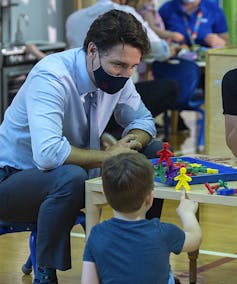
A report released April 13 by University of Toronto researchers highlights what many in the early learning and child-care sector have long known: Canada’s early childhood educators (ECEs) are undervalued, underpaid and under-resourced. Unless governments get serious about addressing their working conditions, a Canada-wide child-care plan will be derailed.

The federal government’s historic $30-billion investment in child care and the agreements signed with provinces and territories prioritize lowering parent fees to $10 per day and expanding the number of child-care spaces. Yet in the race to achieve these goals, the people who provide care are too often overlooked.
More than 300,000 people across Canada work with young children, comprising over one per cent of the employed population. It is a marginalized workforce of mostly women. One in three are immigrants or non-permanent residents, compared to 25 per cent of all other occupations. Since the onset of the COVID-19 pandemic 21 per cent of staff left the sector.
Package of interventions required
Filling current vacant positions needs to happen alongside finding an additional 32,000 educators, plus the support workers needed to staff the 240,000 new spaces Canada has promised over the next five years. Despite an obvious crisis, addressing workforce needs has received cursory attention.
Some provinces and territories have taken steps to raise wages, but across the care economy, there is a reluctance to recognize that creating and maintaining a professional workforce requires a package of interventions to produce inviting jobs.
These include wages and benefits that reflect the value of the work, resources and access to experts to do the job well and opportunities for career advancement. The rub is governments do not need to go far to find educators. Almost as many trained early childhood educators work outside licensed child care, as in it. Working with young children is their first passion, and if offered decent work many say they would return.
Read more: Canada's COVID-19 child-care plan must start with investing in early childhood educators
For the past two years we have been meeting with educators, child-care operators, government officials and researchers to learn about what brings people into child care and more importantly what makes them stay. We document today’s challenges and what needs to quickly change.
Wages
Half the child-care workforce barely earn above the minimum wage. Almost 70 per cent report that their salary does not adequately reflect the skill and knowledge their work requires.
Enrolment challenges in programs brought on by the pandemic resulted in layoffs and unpredictable hours, leading to ECEs leaving the sector to work elsewhere where they earn more. Evaluating educators’ work using pay equity tied to comparable jobs in the public sector would place child care workers on par with their public counterparts.
Recruitment and retention challenges aren’t seen in publicly operated child-care centres where educators are paid substantially more, are unionized and have access to professional development and career opportunities.
Benefits
Paid leave, and decent health and pension benefits are essential recruiting tools. One-third of the child-care workforce receive no health benefits, and only 17.7 per cent have access to employer paid RRSPs or pensions. More than 50 per cent of educators report access to benefits as a reason for staying with their current employer. Governments can include educators in their existing public pension and benefits plans.

Working conditions
Empowering educators to support children to develop into their optimal selves requires expertise and resources. Educators’ knowledge of child development — paired with their relationships with children at a critical early window in children’s lives — means educators can identify child or family challenges and propose interventions or refer families to community or health services.
To successfully accomplish this educators need time to keep their skills current, and have access to professional mentorship and specialists who can help support children and families with greater needs.
Educator training and qualifications
Fewer than half the staff working in government licensed child care have post-secondary credentials in early childhood education. No province or territory requires all staff working with children to have credentials. This is a standard we would never accept within our kindergarten to Grade 12 systems of education. Increasing the percentage of trained staff contributes to better outcomes for children.
Effective engagement
Professional working conditions and the overall quality of a program depend on the leaders at the helm. However, few provinces and territories require additional training for centre directors. Leading a child-care centre is complex, requiring proficiencies in financial literacy and viability, human resource management and educational leadership. Increasing training requirements for program directors will contribute to the quality of care children receive.
Educators’ work environments are children’s learning environments. Children depend on educators who are skilled and knowledgeable. Just as children’s environments can support or impede their learning, educators’ work environments can promote or hinder their ability to do their work well.
Decent work for Canada’s child-care workforce should be more than just a slogan; it must be the foundation of Canada’s early learning and child-care plan to ensure that children receive the high-quality care they deserve.
Emis Akbari receives funding from The Atkinson Foundation, The Margaret and Wallace McCain Family Foundation and The Lawson Foundation.
Kerry McCuaig receives funding from the Margaret and Wallace McCain Family Foundation, the Lawson Foundation, the Atkinson Foundation, and Employment and Social Development Canada.
This article was originally published on The Conversation. Read the original article.







